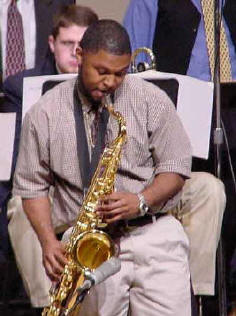|
Saxophone
Vibrato Basics |
| Watch a short video! |
|
| Video - "Saxophone Vibrato Basics" | - 256K - broadband connection | 56K - dial-up connection |
Vibrato is an essential expressive
element of the saxophone sound, and is a concept that can and should be
taught to all intermediate and advanced high school students, and perhaps
even very advanced junior high school students. However, teachers
should ensure when instructing a student to use vibrato that he or she
has the basic mechanics of the horn well established, is already producing
a pleasing sound, and can play relatively well in tune. In other
words, it should not be used to mask deficiencies in tone quality or intonation!
Vibrato on the saxophone is accomplished by very slight up-and-down motions
with the jaw, not with the diaphragm or the throat as on various other
wind instruments. This motion should not be visually perceptible,
but when first teaching vibrato, it is important to allow the student
to overdo these movements. He or she will likely not be accustomed
to moving the jaw and exaggerating it will more quickly teach the proper
action for producing vibrato. Below are several exercises that will
introduce the mechanics required.
Before attempting vibrato on the horn, we must discover how to produce
it. Have your student say the following syllables: “wa-wa-wa” and
“ya-ya-ya,” overdoing the jaw movements. Both of these syllables
produce the correct jaw motion, but beware that the latter also has a
tongue motion that accompanies it. We do NOT want the tongue to
be used in the vibrato, only the jaw. Another very good teaching
tool is to gently chew on the lower lip, first without the mouthpiece
in the mouth, and then with it in playing position.
Once these preliminary exercises have been accomplished, it is time to
attempt them on the saxophone. Have your student pick a note in
a comfortable range (third space C works well), start the pitch with a
straight tone, and then begin moving the jaw using as a model one of the
above examples. Do not practice with any rhythm or meter in mind,
and again, it is important to overdo the motion at first.
When your student is somewhat comfortable moving the jaw while playing,
then he or she can begin to practice the vibrato in a rhythmic context.
Set a metronome at 60 beats per minute, and play a long tone with one
undulation per beat; increase this to two undulations per beat (eighth
notes), then three (triplets) and four (sixteenths). Gradually increase
the tempo, ultimately reaching a goal of producing sixteenth notes at
a metronome marking of 80-90. Subsequent practice should utilize
scales, playing each scale degree as a whole note and using vibrato on
each pitch. Then change the note values to half notes, then quarters,
etc. This will allow one to work for a seamless transition with
the vibrato from one note to the next. Further practice could include
playing one note with vibrato and the next without; or, playing one note
with two undulations, the next with three, the next with one, and so on.
These exercises will increase flexibility with the vibrato, so it is not
simply “on” or “off.”
You will find that introducing the element of vibrato adds a great deal
of personality and musicality to your saxophonists. Again, it is
important that one has the basics of the horn (a good embouchure, proper
air support, and good finger technique) well established before introducing
the concept. By the same token, an advanced student who does not
use vibrato should certainly be taught to use this expressive device.
It is also important to realize that a saxophonist who can play with vibrato
does not have to use it all of the time. It is certainly acceptable,
and sometimes necessary, to play passages non-vibrato. Finally,
a truly musical vibrato is not metered but should be very free and might
be best characterized as a “spinning” sound; using a metronome and purposefully
measuring it is for practice only.
| If you would like to be added to the TSMP Email Mailing List and receive periodic notifications of new articles and updates to this website, then please email TSMP.
The Texas School Music
Project is a source for ideas and information
concerning pedagogical
practices in the music classroom or rehearsal hall. The TSMP is a service provided to
all music specialists by the faculty
of
the Department of Music
at Stephen F. Austin State University. Copyright © 2002, Department of Music at Stephen F. Austin State University |
